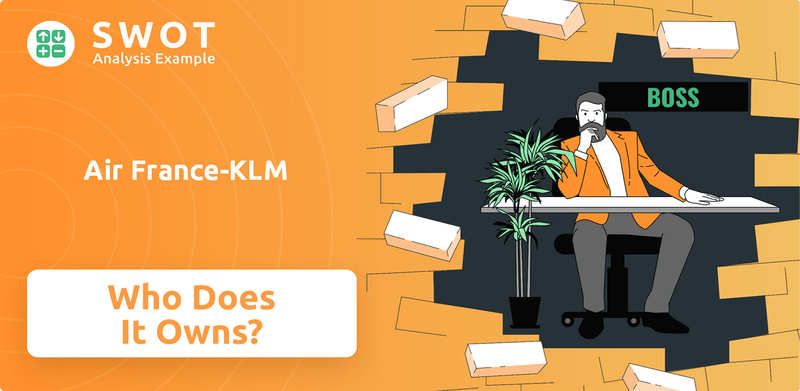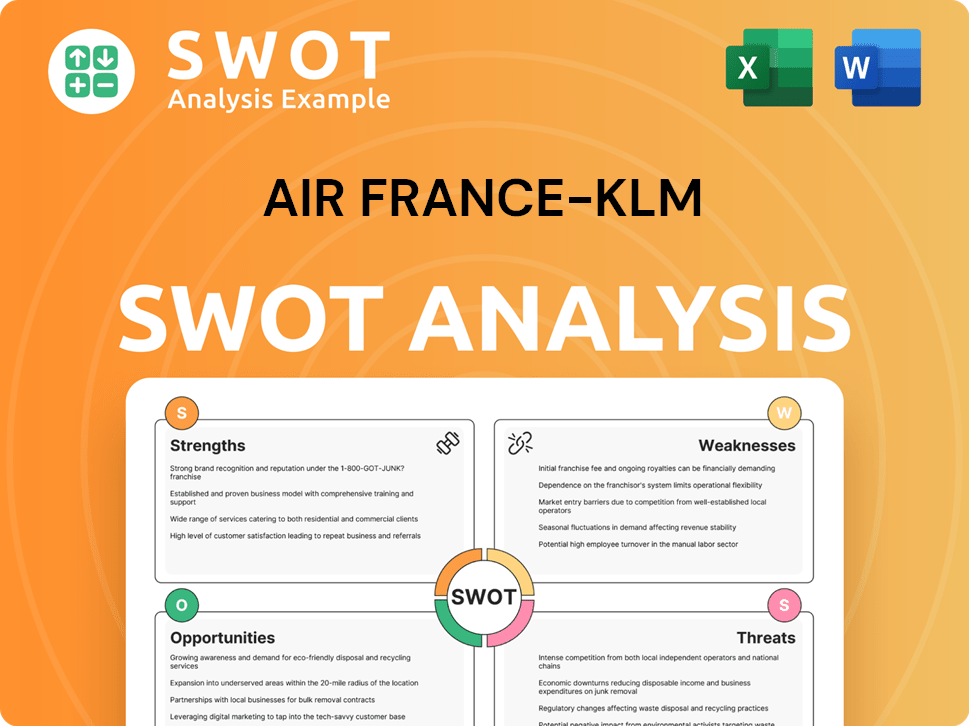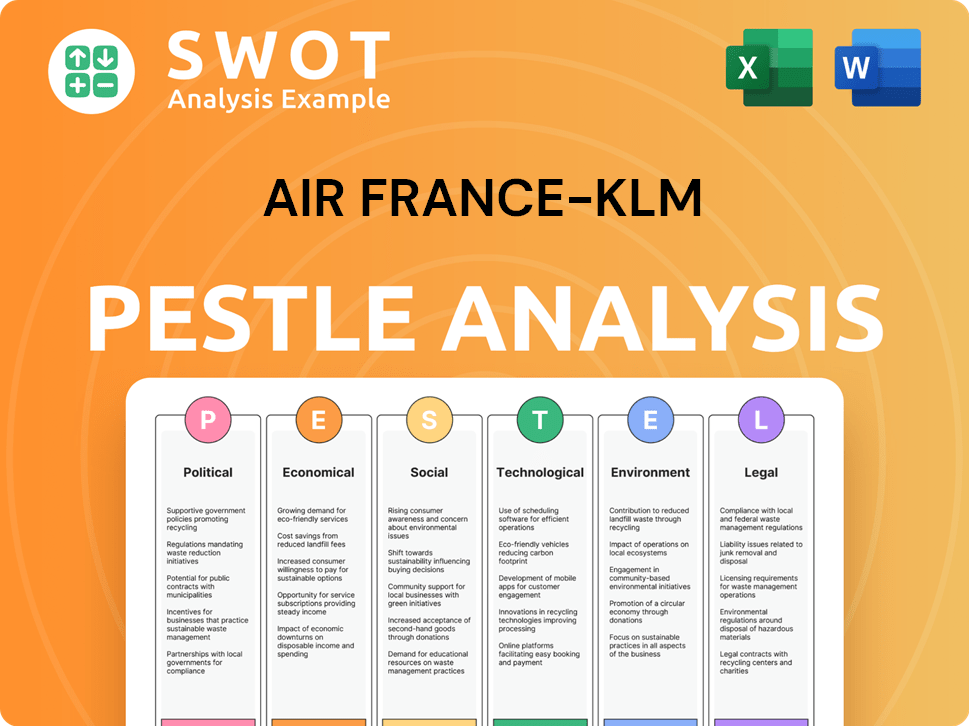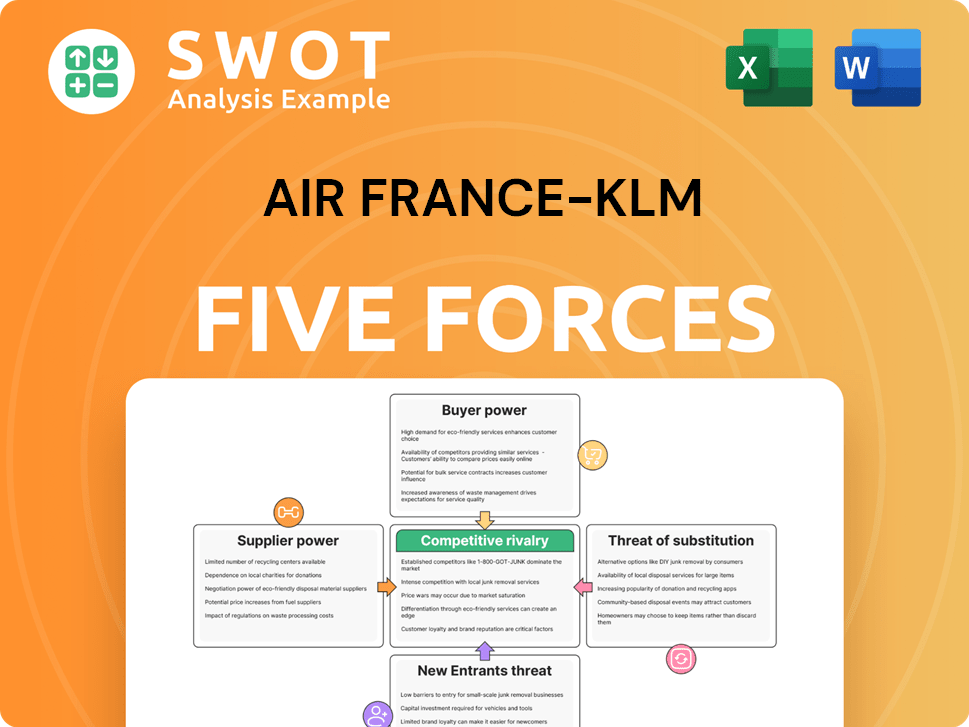Air France-KLM Bundle
Who Really Controls Air France-KLM?
Unraveling the Air France-KLM SWOT Analysis reveals more than just its strengths and weaknesses; it also highlights the critical question of ownership. Understanding who owns Air France-KLM is key to grasping its strategic direction and its place in the global aviation landscape. This Franco-Dutch airline, a product of a pivotal merger, operates across continents, making its ownership a complex and fascinating subject.

The Air France KLM owner structure is a dynamic interplay of stakeholders, from governments to individual investors, each influencing the airline's trajectory. Knowing the Air France-KLM ownership breakdown is crucial for investors, analysts, and anyone interested in the airline industry. This exploration will delve into the major shareholders of Air France-KLM, examining the company's history and its evolving ownership structure, providing insights into who controls Air France-KLM and its future.
Who Founded Air France-KLM?
The current structure of Air France-KLM, and therefore its ownership, stems from the 2004 merger of Air France and KLM Royal Dutch Airlines. Understanding the ownership of Air France-KLM requires looking back at the origins of these two airlines, as each had its own distinct founding and early ownership dynamics. This history is crucial for understanding the current Air France-KLM owner and the Air France-KLM shareholding structure.
KLM (Koninklijke Luchtvaart Maatschappij – Royal Dutch Airlines) was established on October 7, 1919. It was founded by a group of Dutch businessmen, with Albert Plesman playing a key role in its formation. Air France, on the other hand, was created on October 7, 1933, through the merger of multiple French airlines. The French government played a significant role in the consolidation, establishing itself as a dominant shareholder from the beginning.
The early ownership of both airlines was influenced by government involvement, reflecting the strategic importance of national airlines. While the initial equity splits for KLM involved private capital and state investment, Air France saw the French state take a leading role. The Air France-KLM company structure evolved significantly over time, but the initial ownership laid the groundwork for the future.
KLM was founded in 1919 by Dutch businessmen, with Albert Plesman as a key figure.
Air France was created in 1933 through the merger of several French airlines.
Both airlines saw significant government influence in their ownership structures.
KLM's early equity involved a mix of private and state investment, while Air France was primarily state-backed.
National governments recognized the strategic importance of airlines, influencing their ownership.
There were no widely publicized initial ownership disputes that fundamentally altered their initial state-backed or consortium-based ownership.
The initial ownership of Air France and KLM, and thus the current Air France-KLM ownership, was heavily influenced by government involvement. The French government's role in Air France and the Dutch government's early stake in KLM set the stage for the future. For more insights into the financial aspects, consider exploring the Revenue Streams & Business Model of Air France-KLM.
- KLM was founded in 1919 by Dutch businessmen with early government involvement.
- Air France was formed in 1933 through a merger, with the French government as a key shareholder.
- The initial ownership structures reflected the strategic importance of national airlines.
- Understanding the history of these two airlines is crucial to understanding who owns Air France-KLM.
Air France-KLM SWOT Analysis
- Complete SWOT Breakdown
- Fully Customizable
- Editable in Excel & Word
- Professional Formatting
- Investor-Ready Format

How Has Air France-KLM’s Ownership Changed Over Time?
The Growth Strategy of Air France-KLM has been significantly shaped by its ownership evolution, beginning with the 2004 merger of Air France and KLM Royal Dutch Airlines. This merger created a publicly traded entity listed on both Euronext Paris and Euronext Amsterdam, marking a pivotal moment in the company's structure. The initial market capitalization reflected the combined value of two major European airlines, setting the stage for subsequent ownership changes and strategic partnerships.
Since the merger, the Air France-KLM ownership structure has seen several shifts, particularly concerning governmental and strategic holdings. The French and Dutch governments have maintained significant stakes, though the percentages have fluctuated over time. Strategic partnerships with other airlines, such as Delta Air Lines and China Eastern Airlines, have also influenced the shareholding composition, fostering deeper commercial cooperation and network optimization.
| Shareholder | Approximate Capital Held (Early 2024) | Approximate Voting Rights (Early 2024) |
|---|---|---|
| French State | 28.6% | 40.0% |
| Dutch State | 9.3% | 13.1% |
| China Eastern Airlines | 9.6% | Not Specified |
| Delta Air Lines | 5.8% | Not Specified |
Institutional investors, including mutual funds and index funds like BlackRock and Vanguard, hold a substantial portion of the remaining shares. These shifts in the Air France-KLM ownership structure, particularly the reduction of governmental stakes and the introduction of strategic airline partners, have influenced the company's strategic direction. Air France-KLM regularly discloses its major shareholdings in its annual reports and SEC filings, ensuring transparency regarding its ownership.
Air France-KLM's ownership is a mix of governmental, strategic, and institutional investors.
- The French and Dutch governments are significant shareholders.
- Delta Air Lines and China Eastern Airlines are key strategic partners.
- Institutional investors hold a substantial portion of the shares.
- The ownership structure impacts the company's strategic direction and alliances.
Air France-KLM PESTLE Analysis
- Covers All 6 PESTLE Categories
- No Research Needed – Save Hours of Work
- Built by Experts, Trusted by Consultants
- Instant Download, Ready to Use
- 100% Editable, Fully Customizable

Who Sits on Air France-KLM’s Board?
The current Board of Directors of Air France-KLM reflects its diverse ownership structure. As of early 2025, the board includes representatives from major shareholders, independent directors, and employee representatives. Key shareholders like the French State, the Dutch State, and strategic partners such as China Eastern Airlines and Delta Air Lines have board representation. The French State's shareholding ensures its interests are represented in strategic decisions. The board composition aims to balance the interests of various stakeholders, including governmental entities and strategic partners, to guide the airline's strategic direction.
The board's structure is designed to align with the company's strategic goals and operational requirements. Independent directors bring expertise in various fields, ensuring a broad perspective on critical issues. Employee representatives also participate, providing insights into workforce matters and operational realities. This combination of expertise and stakeholder representation supports effective governance and decision-making within Air France-KLM. The board's role is crucial in overseeing the airline's performance and ensuring its long-term sustainability.
| Shareholder | Capital (%) | Voting Rights (%) |
|---|---|---|
| French State | 28.6% | 40.0% |
| Dutch State | 9.3% | 13.1% |
| Other Shareholders (Free Float) | 62.1% | 46.9% |
The voting structure of Air France-KLM generally follows a one-share-one-vote principle for common shares. However, the French State holds double voting rights for shares held for over two years, significantly increasing its influence. The Dutch State also benefits from double voting rights. This dual-class share structure for governmental holdings provides them with considerable influence on major strategic orientations and leadership appointments. This structure has led to stable control, as there have been no major proxy battles reported in recent years. For further insights, consider exploring the Competitors Landscape of Air France-KLM.
Air France-KLM's governance structure reflects a balance of governmental and strategic shareholder influence, ensuring stability and strategic alignment.
- The French and Dutch states hold significant voting power through double voting rights.
- Strategic partners like China Eastern Airlines and Delta Air Lines also contribute to the board.
- This structure supports long-term strategic planning and operational stability.
- The board's composition is designed to balance diverse interests and expertise.
Air France-KLM Business Model Canvas
- Complete 9-Block Business Model Canvas
- Effortlessly Communicate Your Business Strategy
- Investor-Ready BMC Format
- 100% Editable and Customizable
- Clear and Structured Layout

What Recent Changes Have Shaped Air France-KLM’s Ownership Landscape?
In the past few years, the ownership of Air France-KLM has seen shifts due to the impacts of the COVID-19 pandemic. The company, which includes Air France and KLM Royal Dutch Airlines, received significant state aid, leading to changes in the shareholding structure. For example, the French government increased its stake as part of the financial support provided during the crisis. Understanding the Target Market of Air France-KLM is also crucial when assessing the company's strategic direction and financial health, which can influence ownership dynamics.
More recently, there's been a move towards stabilizing the ownership, with both the French and Dutch states remaining key shareholders. Air France-KLM has focused on strengthening its financial position. This includes efforts to reduce debt and optimize its capital structure, which can sometimes involve share buybacks. These actions are often balanced against the need for ongoing investments and debt reduction, influencing the company's long-term ownership strategy.
| Shareholder | Approximate Stake (as of late 2024/early 2025) | Notes |
|---|---|---|
| French State | Around 28% | Significant shareholder, reflecting government support during the pandemic. |
| Dutch State | Around 9.8% | Important shareholder, representing the interests of the Netherlands. |
| Institutional Investors & Public Float | Remaining Shares | Includes various institutional investors and public shareholders. |
Airline ownership trends show continued interest from institutional investors, as well as strategic alliances through equity stakes or joint ventures. Air France-KLM's partnerships with Delta Air Lines and China Eastern Airlines, which involve cross-shareholdings, highlight this trend. Public statements often emphasize maintaining a strong financial position and optimizing the fleet, which can indirectly affect future ownership changes.
The ownership structure includes significant stakes held by the French and Dutch states. Institutional investors also hold a substantial portion of shares. Strategic partnerships influence the company's ownership landscape.
The French government is the largest shareholder, followed by the Dutch government. Other shares are held by institutional investors and the public. These stakeholders play a crucial role in the company's direction.
Partnerships with airlines like Delta Air Lines and China Eastern Airlines are formed through equity investments. These alliances help to strengthen market positions and share resources. Cross-shareholding is a common strategy.
The focus is on maintaining a solid financial position and reducing debt. The long-term trend in the airline industry often leans towards a more diversified shareholder base. This may lead to changes in the future.
Air France-KLM Porter's Five Forces Analysis
- Covers All 5 Competitive Forces in Detail
- Structured for Consultants, Students, and Founders
- 100% Editable in Microsoft Word & Excel
- Instant Digital Download – Use Immediately
- Compatible with Mac & PC – Fully Unlocked

Related Blogs
- What are Mission Vision & Core Values of Air France-KLM Company?
- What is Competitive Landscape of Air France-KLM Company?
- What is Growth Strategy and Future Prospects of Air France-KLM Company?
- How Does Air France-KLM Company Work?
- What is Sales and Marketing Strategy of Air France-KLM Company?
- What is Brief History of Air France-KLM Company?
- What is Customer Demographics and Target Market of Air France-KLM Company?
Disclaimer
All information, articles, and product details provided on this website are for general informational and educational purposes only. We do not claim any ownership over, nor do we intend to infringe upon, any trademarks, copyrights, logos, brand names, or other intellectual property mentioned or depicted on this site. Such intellectual property remains the property of its respective owners, and any references here are made solely for identification or informational purposes, without implying any affiliation, endorsement, or partnership.
We make no representations or warranties, express or implied, regarding the accuracy, completeness, or suitability of any content or products presented. Nothing on this website should be construed as legal, tax, investment, financial, medical, or other professional advice. In addition, no part of this site—including articles or product references—constitutes a solicitation, recommendation, endorsement, advertisement, or offer to buy or sell any securities, franchises, or other financial instruments, particularly in jurisdictions where such activity would be unlawful.
All content is of a general nature and may not address the specific circumstances of any individual or entity. It is not a substitute for professional advice or services. Any actions you take based on the information provided here are strictly at your own risk. You accept full responsibility for any decisions or outcomes arising from your use of this website and agree to release us from any liability in connection with your use of, or reliance upon, the content or products found herein.